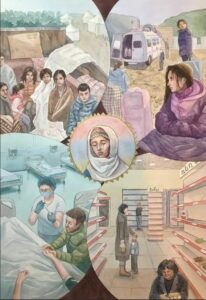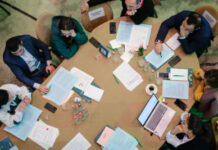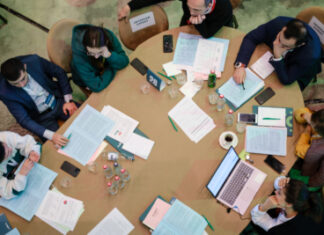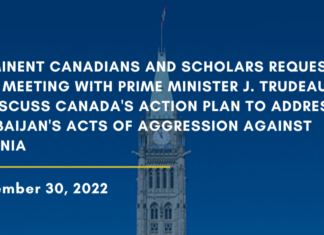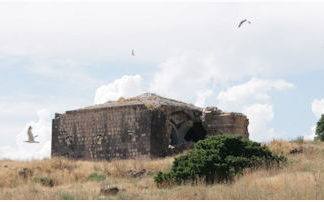Armenia — still a part of the Soviet Union — was suddenly in the world’s spotlight, as former Mirror- Spectator editor Barbara Merguerian recalls.
“The Soviet Union for the first time allowed outside help,” Merguerian recalled. “And the result was an outpouring of help from the diaspora. Having been born in America, it was strange (seeing) Armenia on the front page. It was distressing.”
For the first time in the Soviet Union’s history, humanitarian aid from Western governments and the world’s population at large was allowed into the country.
Dr. Carolann Najarian, who made her first trip to help victims in January 1989, remembers that after the earthquake, the dynamic between the Soviet Bloc country and the West changed.
“Armenia opened up to the outside world, and people poured in from all over,” Najarian said. “From day one, there was no more Iron Curtain.”
An Outpouring of Help
Najarian, who still maintains efforts to help the earthquake’s victims, will be speaking at a memorial concert titled “Music for Life” at the National Heritage Museum in Lexington, Mass.
Najarian has been working with victims through the Armenian Health Alliance (AHA), which she founded in response to the need for help. The organization established a primary care center in Gumri in 1994 and a center for pregnant women in Karabagh a year later.
“What I think was very special about that time was that a terrible disaster brought the Armenian community together,” Najarian said. “Volunteerism reached new heights from all parts of the community. People got to know each other and it strengthened the community tremendously.”
Merguerian also remembers the aftermath of the earthquake as a time when the diaspora became more conscious of the welfare of Armenians.
“When we first got the news, we didn’t realize how serious it was,” Merguerian said. “It built up over time. It was a turning point in the relations between the Armenians and the diaspora be cause we realized we depended on each other.”
Relief efforts also coalesced through the Armenian Church and the leaders of the Eastern Diocese, headed by Archbishop Torkom Manoogian, set off for Armenia to see what help they could offer.
“Imagine some of what we found: a blockaded border, hundreds of thousands of homeless refugees, a total breakdown of essential services, a destroyed distribution system and an overwhelmed Soviet bureaucracy. There was also the chaos caused as relief agencies from many nations were attempting, all at once, to pour massive aid into Armenia,” said Kevork S. Hovnanian who accompanied Manoogian in 1988. “It was painful to see the plight of the Armenians, and we had to help by arranging for all possible aid as quickly as we could.”
After assessing the situation, the American-Armenian community began to provide medicine and medical equipment, food and vitamins, clothes and blankets and temporary shelter. The first shipments arrived just days after the earthquake. This effort of the Armenian Church evolved into the Fund for Armenian Relief (FAR).
FAR initially focused on reconstructing demolished homes and schools as well as distributing food. It also provided medical assistance, clothing, agricultural equipment and seeds, television and radio antennas, irrigation and potable water pipes, skills training in various domains and small business development opportunities. FAR caters its general relief and development programs to meet the changing needs of the people in Armenia.
“FAR was instrumental to overcome the suffering in Armenia after the 1988 earthquake. Much has been done, more has to be done in the future. FAR has evolved and today, we are proud to be a true partner in the continued growth of Armenia’s economy and society. Hope, opportunity, and empowerment — a helping hand — this is how we at FAR are helping Armenian people design their own future,” said Archbishop Khajag
Barsamian, the president of FAR. Living in the Aftermath
Both Najarian and Merguerian said much of Armenia continues to struggle with the effects of the earthquake, which many say was worsened by poor construction practices.
“I don’t think [the authorities] are any more organized,” Najarian said. “I think what we as a community helped to do was get them out of the acute crisis. After that, there were longer-term issues and they didn’t get all the promised help. [Former Soviet leader Mikhail] Gorbachev said [the country] would be rebuilt in two years. It’s still not re-built. There has been progress, but there are still people living in pretty dismal consequences.”
Najarian continues to work with Armenians in need of medical assistance through the AHA.
While pointing out the nature of her work means she sees people at their most desperate, Najarian said she is surprised the earthquake’s effects have lasted so long. “People I work with are still struggling,” she said. “I thought when I first started that in five years the need would not be there anymore, but that’s not what happened.”
“Music for Life” will be hosted at the National Heritage Museum on December 7 at 2:30 p.m. Admission is free.
